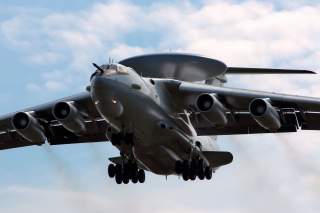South Korean Fighters Fired 300 Warning Shots at Russian A-50 AEW&C Aircraft
A major incident.
“We confirmed Russia’s A50 has invaded Japan’s airspace while two of Russian Tu-95 bombers and two Chinese H-6 bombers flew around Japan. We took measures against the invasion,” said a spokesman for the country’s Ministry of Defense.
On Jul. 23, 2019 warplanes from four countries faced off in a chaotic and unprecedented confrontation above a small, disputed island off the coast of South Korea and Japan.
As reported by CNN, South Korea’s Joint Chiefs of Staff issued a statement claiming they that after a Russian Beriev A-50 airborne early warning and control (AEW&C) aircraft had twice violated the country’s airspace, Republic of Korea Air Force (ROKAF) fighters had fired more than 300 warning shots at it, the first such incident between the countries.
Moscow furiously denied Seoul’s account of the encounter, claiming that South Korean military jets had dangerously intercepted two of its bombers during a planned flight over neutral waters.
But in a statement Tuesday afternoon, Japan’s Ministry of Defense backed up South Korea’s claims, saying the A-50 had flown over the islands and that Tokyo had scrambled fighters to intercept.
Moreover, both South Korea and Japan said that two Chinese H-6 bombers had joined the Russian military aircraft on sorties through the region as well.
The confrontation took place over disputed islands in the East Sea, also known as the Sea of Japan, in the morning of Jul. 23.
The two, small islands, known to the Koreans as Dokdo and to the Japanese as Takeshima, are claimed by both countries.
The reason that sparked the confrontation between the warplanes remains unknown, but analysts said the mission may have been designed by Russia to draw out South Korean and Japanese aircraft for intelligence gathering purposes.
“This mission will have given them a comprehensive map of the (South Korean) national air defense system,” said Peter Layton, a former Royal Australian Air Force pilot and analyst at the Griffith Asia Institute.
The incident came during what South Korean officials have claimed was a joint Russian-Chinese military exercise.
According to South Korea, two Chinese H-6 bombers passed into Seoul’s Air Defense Identification Zone (KADIZ) beginning from 6.44 a.m., joined by two Russian Tu-95 strategic bombers.
The four planes then entered the KADIZ together at about 8.40 a.m. and remained there for 24 minutes.
Airspace is defined as the area 12 nautical miles from a country’s borders, which falls entirely under its control. An ADIZ is an area in which the controlling country demands identification, location and control of aircraft’s direction, but doesn’t necessarily have any rights of engagement under international law.
South Korea’s KADIZ was first established in 1950 and most recently adjusted by Seoul in 2013.
After the KADIZ flyover, Seoul said a Russian A-50 flew above the contested islands first at 9.09 a.m. local time and then again at 9.33 a.m., each time for just a matter of minutes.
In response, South Korea deployed F-15 and F-16 fighter jets, the statement said, and fired 360 warning shots ahead of the Russian aircraft, 80 during the first violation and 280 during the second. The shots were fired using 20mm guns, according to the country’s Ministry of Defense.
The South Korean military said they also sent out 30 warnings to the Russian plane but received no response.
The Russian Defense Ministry furiously denied the South Korean reports and accused South Korean fighter pilots of acting inappropriately.
“(They) conduced unprofessional maneuvers by crossing the course of Russian strategic missile carriers, threatening their security,” the ministry said in a statement Tuesday. The statement made no mention of the A-50.
“This is not the first time the South Korean pilots have unsuccessfully tried to prevent Russian aircraft from flying over the neutral waters,” the Russian statement said, adding it didn’t recognize South Korea’s KADIZ.
It also denied that there was any “warning fire,” adding if the Russian pilots had felt “any threat to their security, the response would not be long in coming.”
But after Moscow released its statement, Japan confirmed it had also scrambled fighter jets in response to the Russian incursion Tuesday.
“We confirmed Russia’s A50 has invaded Japan’s airspace while two of Russian Tu-95 bombers and two Chinese H-6 bombers flew around Japan. We took measures against the invasion,” said a spokesman for the country’s Ministry of Defense.
When asked about the incident, the Chinese Ministry of Foreign Affairs said they weren’t aware of the details and referred the question to the Defense Department.
“You used the word ‘intrusion’ and I’d caution against using such terms, considering China and South Korea are friendly neighbors and the situation is not clear yet,” spokeswoman Hua Chunying said.
This article by Dario Leone originally appeared on The Aviation Geek Club in 2019.
Image: Wikimedia.

